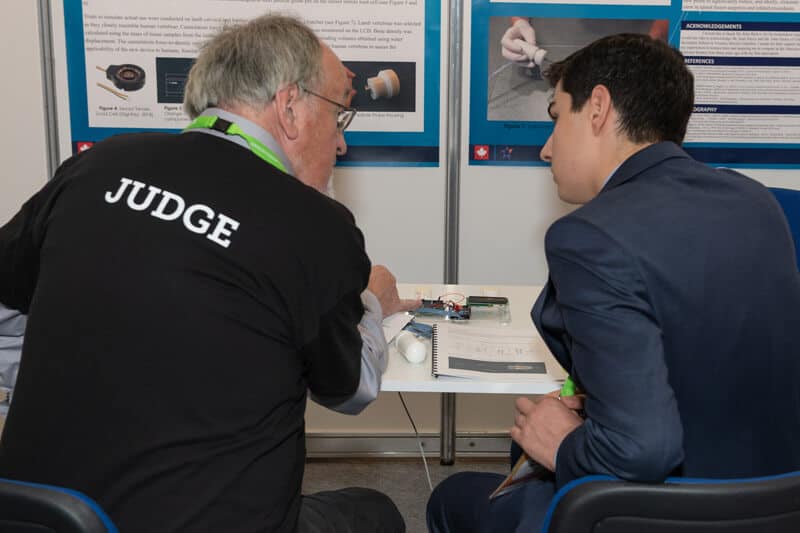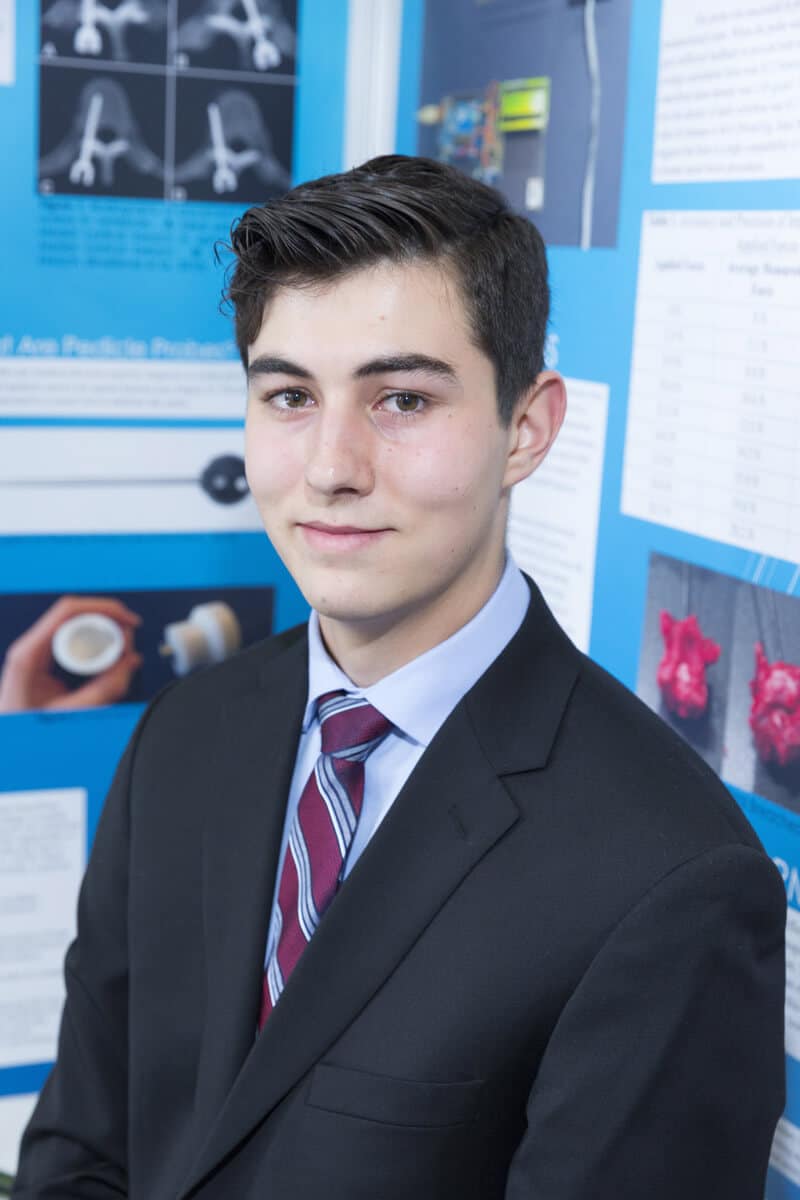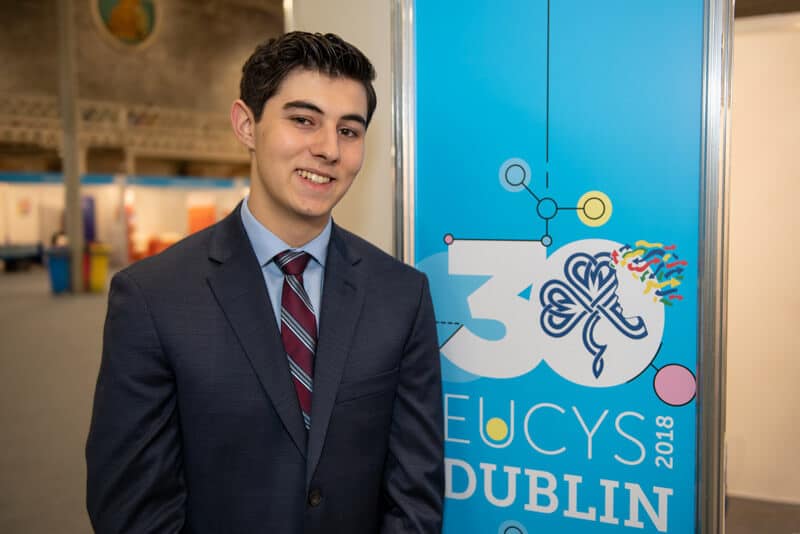Nicolas Fedrigo from Canada, only 17, is becoming a promising superstar in the world of scientific innovations thanks to his fascinations with advanced technologies. Grade 12 student from Claremont Secondary […]
Nicolas Fedrigo from Canada, only 17, is becoming a promising superstar in the world of scientific innovations thanks to his fascinations with advanced technologies. Grade 12 student from Claremont Secondary School has won a first place award at 30th EU Contest for Young Scientists 2018 in Dublin for developing a tool that prevents vertebral breaches in patients who undergo a type of spinal surgery, called spinal fusion. That way, in the future, complications such as infection and paralysis could be avoided during the postoperative period. This is just one of many awards and recognitions in his biography. In order to test his ideas, this ambitious young man carried out all the work in his kitchen, using a lamb vertebrae bought from a local butcher!
Dear Nicolas, tell us more about the first time you discovered the beauties of science and how did that look like?
I have always been fascinated by science and engineering. However, the first time I became actively involved was three years ago when my science teacher Mr. Sean Hayes inspired me to compete in science fairs. I entered into a regional science fair, qualified for nationals, and I have been competing ever since. My projects encompass addressing real-world medical issues through engineering.

What was the first significant project you worked on that made you select science as your definite professional choice?
Through science fairs, it became clear to me that I want to pursue a career in engineering. Three years ago, I competed in my first science fair, where I designed wearable technology to regulate the user’s core body temperature for athletic and medical benefits.
What are your impressions about EUCYS 2018 and how will the fact you received the second award for your medical invention affect your future work?
Competing in science fairs is an amazing experience and the ideal outlet for exploring the field of science and engineering. After qualifying for and competing at the Canada Wide Science Fair for the past three years, I achieved Best Senior Overall at the national level – allowing me to represent Canada at the European Union Contest for Young Scientists. This fair was hosted in Dublin Ireland and it was an amazing experience. I was able to spend time with participants from all over the world, undergo a conversational judging process, and tour the city. By the end of the week, I was awarded a First Place Overall Award which was an honor to receive.
You are only 17, yet your stunning biography counts numerous significant recognitions and inventions. The latest one is first ever invented sensor-enabled pedicle probe that should prevent vertebral breaches from occurring during spinal fusion surgery. Can you tell us more about the process of creating the probe and who helped you in this project?
I began developing my redesigned pedicle probe less than a year ago. This took place on my kitchen counter and I carried out all the work on my own. I even conducted tests on lamb vertebrae (obtained from a local butcher) at home. I am continuously developing and refining my redesigned probe; however, I was able to quickly develop the first working prototype in a two-month period. Throughout all my science fair projects, my mentor Mr. Sean Hayes supported and encouraged me.
What is a sensor-enabled pedicle probe and how does it work?
My goal was to make spinal fusions safer by redesigning the pedicle probe to provide surgeons with instantaneous feedback on the probe’s location, enabling them to more-accurately place pedicle screws. The electromechanical pedicle probe I developed detects the difference between the higher density cortical (compact) bone and lower density cancellous (spongy) bone found in vertebrae. It provides real-time feedback to surgeons, similar to the popular 1960s game Operation, warning of a potential vertebral breach, enabling them to redirect the probe and advance down the optimum path. This new technology is a proof-of-concept prototype that demonstrates it is possible to prevent vertebral breaches, making for more reliable spinal fusion procedures through guided trajectory navigation.

It seems like the biomedical engineering is one of the key new scientific branches that is yet to help in treating serious health problems. Where do you see yourself in a decade when it comes to implementing your engineering skills in medicine and biology?
I have carried out cancer research at the BC Cancer Agency in the past, and I was intrigued by the advanced technology and equipment that I was surrounded by. In ten years, I could see myself developing biomedical technology to support cancer researchers.
#How pedicle probe works: Twenty-nine percent of patients who undergo spinal fusion surgery suffer from accidental damage to the spinal cord from pedicle screws, causing various complications, including paralysis. Nicolas wanted to make spinal fusions safer by redesigning the pedicle probe, tool used to direct placement of the screws to provide real-time feedback on the probe’s location. A probe detects the difference between the higher density compact bone and lower density spongy bone in vertebrae. The probe warns the user when it contacts the wrong type of bone with a vibration and a light, informing the surgeon to redirect the probe to place screws correctly. Hopefully, this invention could significantly reduce the incidence of vertebral breaches during spinal fusion surgery.
Author: Jelena Zoric
Photo credits: André Van Vugt, Reni Barlow
Support us!
All your donations will be used to pay the magazine’s journalists and to support the ongoing costs of maintaining the site.
Share this post
Interested in co-operating with us?
We are open to co-operation from writers and businesses alike. You can reach us on our email at cooperations@youthtimemag.com/magazine@youthtimemag.com and we will get back to you as quick as we can.










